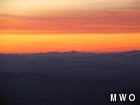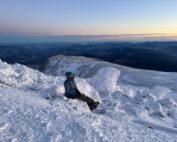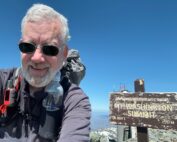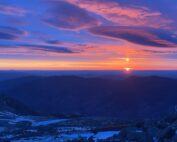WFA & Sunset
2008-10-24 16:59:53.000 – Mike Carmon, Summit Intern
Camel’s Hump & Mt. Whiteface
If you come to the Observatory on a typical day, you’ll find two or three observers, an intern or two, a volunteer or two, and maybe a museum attendant, depending on the time of year. However, this past Wednesday and Thursday, the entire crew was up overnight. That included five observers, two interns, a couple of Snow Cat operators, Ken, and a volunteer. The occasion? Wilderness First Aid Training. Over those two days, we all participated in a crash-course in basic Wilderness First Aid. We all got tons of practice in patient examinations, splint-making, and what to do in specific emergency situations that may arise in our time on the summit. Very rarely, if ever, is everyone from both shifts together on the summit overnight, so it was a special occasion. Working opposite shifts doesn’t allow members of one shift to spend any appreciable time with members of the other shift. As you might imagine, the kitchen was filled to the brim at lunch and dinner time, and the living area was much louder and more dynamic Wednesday night than most nights on the summit.
Thursday afternoon, the first aid training was completed, and the departing shift was able to get out of dodge (a day late). A few hours after their departure, those of us left behind were treated to quite a spectacle. As I was working in the weather room around 5 pm (EST), Brian called my attention to the sunset that was going on behind us. The colors were nice, but the most exceptional part of the show was the fact that some of the peaks that are typically only faintly visible and fuzzy to us appeared unusually clear and sharp. Pictured above is a photo from the sunset last night.
Camel’s Hump, which is about 80 miles west of the summit, appears as the most prominent peak in the center of the photo. The peak immediately to the right of Camel’s Hump is Mt. Whiteface, which stands 130 miles from the summit in the Adirondacks of New York State. Generally, this peak appears very faint and is usually the limit of our horizontal visibility. The extremely dry air provided there were no obstructions to our view, and the position of the setting sun lit up these peaks in an almost perfect fashion. The exceptional view capped off a hectic and unusual two days at the Observatory.
Mike Carmon, Summit Intern
Ridgelines and Ravines: A Winter Exploring on Mount Washington
Ridgelines and Ravines: A Winter Exploring on Mount Washington By Marin MacDonald It’s been a cold and windy winter up here on the summit! Since my last blog post, I’ve learned how to forecast
Seeking 17 Peaks: Meet Steward Chris Nichols
Seeking 17 Peaks: Meet Steward Chris Nichols By Chris Nichols Hello Everyone, My name is Chris, I turned 61 back in February and I will be participating in Seek the Peak 2025. This is
Loving The High Life: My Internship on Mount Washington
Loving The High Life: My Internship on Mount Washington By Mees Franssen Hello again everyone! It’s Mees, one of the summit interns this winter, with an update on how my internship has been going






